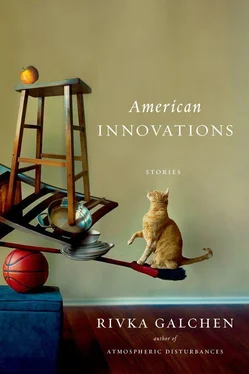1 ...6 7 8 10 11 12 ...33 * * *
I woke up alone on Jacob’s futon. At first I couldn’t locate Jacob, but then I saw he was sleeping in his daughter’s loft. His mouth was open; he looked awful. The room smelled of MSG. I felt at once furious and small. I left the apartment, vowing never to go to the coffee shop — or anywhere else I might see Jacob — again. I spent my day grading student exams. That evening I went to the video store and almost rented Wuthering Heights, then switched to The Man Who Wasn’t There, then, feeling haunted in a dumb way, ended up renting nothing at all.
Did I, in the following weeks and months, think of Jacob often? Did I worry for or care about him? I couldn’t tell if I did or didn’t. Can I even say I’m sure that Jacob was delusional? When King Laius abandons baby Oedipus in the mountains, from fear of the prophecy that his son will murder him, Laius’s attempt to evade his destiny becomes its engine. They call this a predestination paradox. It’s a variant of the grandfather paradox. At its heart is inescapable fate.
The general theory of relativity is compatible with the existence of space-times in which travel to the past or remote future is possible; we are told by those who would know that the logician Kurt Gödel proved this in the late 1940s. But whether or not a person, in our very particular space-time, can in fact travel to the past — no one knows. Maybe. Surely our world obeys rules still alien to our imaginations. Maybe Jacob is my destiny. Regardless, I continue to avoid him.
Gross income for the daughter in 2007 was $18,150. Gross income for the mother in 2007 was $68,742. Gross income for the daughter in 2008 was $23,450; in 2009, it was $232,476; in 2010, $140,702; and in 2011, $37,853. The mother’s gross income for the years 2008 to 2011 inclusive has not been ascertained. But it is believed to have been, in each of those years, not more than $99,999 and not less than $40,000. Income averaging has not been allowed under the federal tax code since 1986.
From 2007 to 2011, the daughter put $170,000 into savings: $25,000 went into a SEP-IRA, $9,000 went into a Roth IRA, and the remainder was placed in a money market fund. Other money went, as the mother might put it, into the hands of petty charlatans who didn’t make it into law or medical school and whose parents, with their values, never taught them anything, poor things, actually, poor things. Or it went, as others might put it, into the hands of venders of artisanal chocolates and $90 T-shirts.
In 1997, while the mother was employed as a technical consultant at a corporation then of good financial standing — though it should be noted that within seven years the corporation then of good financial standing had downsized to 32 percent of its 1997 size and the mother was among those who had not retained their positions, and though she had received a variety of severance package, it was not a variety worth describing and so it will not be described, and the option that the mother had thought she had to retain her health insurance at the same corporate rate had, despite many phone calls, not materialized; instead, the rate offered was more than three times what it had been previously. To return: While holding this position, in which she was consistently earning upward of $90,000 per year, plus respectable benefits, the mother made a down payment of $65,000 toward the purchase of a modest one-bedroom apartment in a condominium building in good standing on the far but not too far east side of Manhattan’s Upper East Side. Fungibility precludes saying where the money for the down payment came from — whether from contemporary earnings or from preexisting savings. It was what it was. Money was spent. Or, rather, was converted into an asset.
The mother purchased the apartment not for herself but for her daughter. It was not intended, however, that the daughter live in the apartment. The daughter did not live in, or even very near, the city of New York. The apartment was, rather, an investment gift. An informal living trust. Both the mother’s and the daughter’s names were put on the mortgage. Both the mother’s and the daughter’s names were put on the title. The daughter was specified as 99 percent owner, and the mother was specified as 1 percent owner. This arrangement was superior for tax purposes and in the case of unexpected death. The mother intended that the asset/apartment could be rented for a sum that would cover the combined mortgage and maintenance payments, and this, more or less, happened.
Although not really: the asset/apartment was “rented” for free to the mother’s son — the daughter’s brother — until such time as he and his new and approved-of and soon-to-be-pregnant wife felt more financially stable. During this time of intrafamilial “renting,” the mother covered the monthly mortgage and maintenance payments herself. A substantial portion of the mortgage payment, being interest rather than principal, was tax deductible, she (the mother) notes. So it wasn’t really such a draining gift, the mother says. The reason the mother had purchased the asset/apartment in behalf of her daughter, as opposed to in behalf of her wed and soon-to-procreate son, was that the mother had, a number of years earlier, made an investment of similar size in behalf of her son, and so the mother felt that this second gift, to her second offspring, was only fair. The first offspring would live there, but the asset part of the asset/apartment would all the while offer a measure of financial security to the second offspring. It is true that, in general, the mother greatly preferred men to women — the daughter similarly greatly preferred men to women — but the mother nevertheless, most likely, loved her children equally, inasmuch as it is not nonsensical to make equating statements about nonfungibles such as love.
One was trying to account for things. To appreciate was to estimate justly.
Regarding the relations between men and women generally, the mother had, early and often, instructed the daughter that: A Woman Should Always Be Financially Independent. On the point of financial independence, the daughter agreed with the mother. And still agrees. However, the daughter’s accord with the postulate, which was during childhood like a faith in the gnostic cult of numbers of Pythagoras, later became a variety of realpolitik. (The mother’s realpolitik outlook was like a faith in a gnostic cult of numbers.) Regardless of any kind of regarding of the relations among men, women, and finance, the aforementioned asset/apartment, between 1998 and 2006, appreciated in value by approximately $512,000. It was then sold, which left, after all expenses, kind of a lot of money. All of which was put into a bank account somewhere. The daughter did not know where. The mother did. Later this led to a dispute.
* * *
In 1994, the daughter had moved from the family home to a dorm room at a sufficiently prestigious university. The usual education loans were applied for, approved, and taken. The loans were taken under the daughter’s name. The daughter held a number of on-campus jobs. The daughter was relatively frugal in those years. But it would be fair to say that the mother paid for most everything. Also in 1994, the mother was widowed, to the gain of no pension or Social Security; the nongain was due to technical problems, problems that probably could have been overcome, but there was just so much to do, it seemed.
During the first year of mother-daughter residential separation, a year that also witnessed the trial of O. J. Simpson, the mother mailed the daughter various photographs of the prosecutor Marcia Clark. The mother greatly admired Marcia Clark’s outfits. She hoped the trial lawyer’s style might positively influence, perhaps even inspire, the daughter, who did not dress like Marcia Clark, and who did not seem to be on track to becoming anything like Marcia Clark. The daughter did not appear to be en route to becoming any variety of Financially Independent Woman with which the mother was familiar. One might even say — one being alternately the mother and the daughter — that this was the mother’s fault: the mother had packed so many lunches, had paid for so many lessons, had so often put towels and clean clothes in the dryer for five minutes so they’d be warm for the daughter after a bath, that she, the daughter, had understandably developed a misimpression of what life was like. Now the daughter needed guidance. At the end of 1995, the mother moved to the same town to which the daughter had moved. Also at the end of 1995, the daughter began a relationship with a young man; after that relationship had begun, the daughter’s ability to register anything about any situation save the young man’s presence or absence in it declined precipitately. The daughter and the young man later married. The mother said she was glad for this. This was one of the few decisions made by the daughter of which the mother approved. The mother paid for the wedding.
Читать дальше
Конец ознакомительного отрывка
Купить книгу












